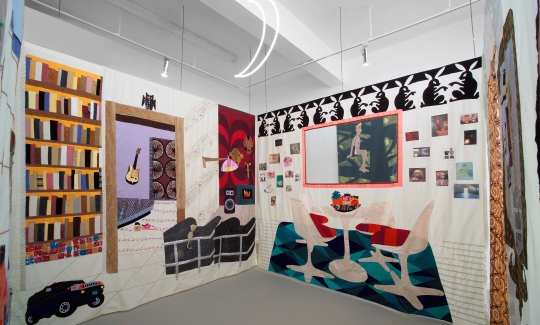Curator: Tal Yahas
What transforms a place into a home? What embodies the idea of a home, and in what manner? Whereas the term "house" defines a physical residence, the term "home" refers to an imagined sphere of concepts and values that give expression to a sense of identity, identification and belonging. In this installation, which depicts a domestic interior and a garden through a combination of quilting on fabric and found objects, Anat Shalev examines the gap between the real and imagined dimensions of this term.
Shalev's unique artistic language was already given expression in her earlier works - in "paintings" sewn or pasted together out of dense, multilayered fabric or paper collages. Her works are suffused with subtle humor and with a profoundly humanistic quality. They constitute a postmodern, feminist paraphrase on painting assembled out of everyday materials and based on "female" activities such as cutting, sewing, quilting and pasting. These works are characterized by dense and colorful ornamental designs and by the combination of patterns from numerous sources to evoke different historical periods and geographical locations.
Shalev is an artist who usually creates in two dimensions; yet although the technique employed in this installation remains partially two dimensional, the stretches of cloth are hung in a manner that produces a self-enclosed, three-dimensional space. Beyond the concrete images of the house and garden, the structure of the installation establishes the relationship between inside and outside as a concrete physical experience: the viewer is first exposed to the back side of each stretch of cloth, and perceives the traces of the sewing process before he discovers the images themselves. He thus finds himself engaged in a somewhat voyeuristic act as he searches for a way into the domestic interior.
The house created by Shalev is composed of numerous details culled from an autobiographical lexicon of images. These images are related also to collective ways of defining identity in terms of gender, familial status and ethnic origins (for instance, the box of Matzah Balls in the kitchen). The artist also introduces references to her favorite artworks (the "postcards" in the dining-room area bear reproductions of works by Hokusai, Marina Abramovic, Wolfgang Tillmans and others). Other objects express heartfelt wishes and fantasies (such as the Le Corbusier armchairs). This fantasy world is ruptured in some instances by allusions to her personal, everyday reality - such as her son's toy jeep, which lies in the foreground of one of the images.
Despite Shalev's detailed attention to every object in the imagined domestic space, this work is subtly pervaded by a doubtful and ironic tone. A row of suitcases stands at the entrance to the house; moreover, it seems that despite the physical and cultural charge that is supposed to function as an existential anchor of belonging and stability, the home remains an ephemeral and fragile concept - an elusive, longed-for entity that does not necessarily belong to the realm of the concrete.

